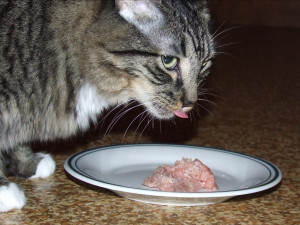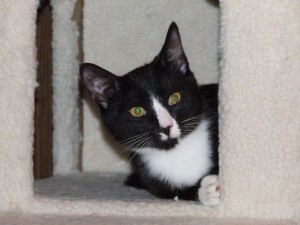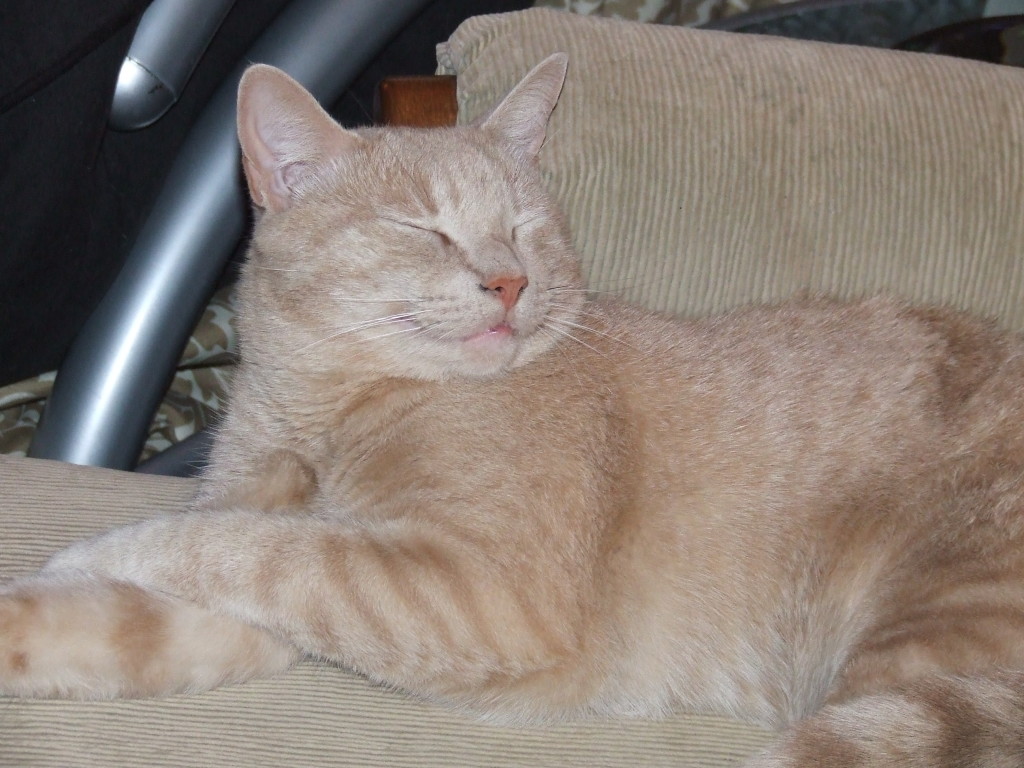Written by Tracy Dion, November 2015.
You can find more information on transitioning basics and troubleshooting in the Transitioning Your Cat to Raw section, and everything you need to create and feed homemade ground, prey model and whole prey diets in the Raw Feeding section.
I’ve been asked about transitioning to ground raw for longer than this website’s been live. Although it’s difficult to answer generic raw feeding transition questions due to the variables unique to each cat owner’s situation, and pretty much impossible to create a precise “1-2-3 Steps to Transition” that will work for every cat, I can, however, offer a guideline loaded with tips that can be adapted to your particular circumstances.
 Take a chance!
Take a chance!
First thing? Go ahead and offer your cat a plate of ground raw. If she takes it, then you’re good to go and can begin feeding raw right away. Many cats need a gradual transition, but some take to raw like they’ve been waiting all their lives for it. Give your kitty the chance to dive right in!
This is especially true for younger cats. Young cats and kittens haven’t yet had their “tastes” distorted by canned or kibble product textures and (overly pungent) odors and often take to raw foods quite readily.
Note: If at all possible, kittens should be weaned directly to prey model or whole prey meals so they don’t have to relearn how to eat later when you’re ready to upgrade from ground raw.
If your cat doesn’t accept the raw right away, then you can move into your transitioning plan.
Ease your way into it.
At this point, you’ve already accustomed your cat to eating three to four scheduled meals a day and you should, of course, be feeding her on a flat plate (to respect those delicate whiskers).
This is critical – if you do not close the 24/7 kibble buffet before you start transitioning your kitty to raw, you will be undermining all of your efforts to get her on a healthy diet and setting you and your kitty up to fail.
To begin the transition, roll the ground raw into a pea-sized ball and put it on the side of the plate next to your cat’s regular food, then put her plate down. Leave the plate down for 30 minutes to give her a chance to try the raw out of curiosity – then take it up and throw it away. Even if she ignores the raw completely, having it there will acquaint her with the sight and smell of it, and over time, she will begin to associate it with food.
Buy or make several different batches of the raw and rotate through them just as you do (or should be doing) with her regular meals.
You can also just mix the ground raw right into your cat’s regular canned or kibble food, but you’ll need to be watchful with this method. Some cats will eat around the raw if they can, and some will refuse to eat the mixed food altogether. Skipping one or two meals a week shouldn’t cause any issues, but missing too many meals – especially if your cat is overweight – can cause hepatic lipidosis, a life-threatening disease. So you can’t use hunger to force your cat to eat something new, and you shouldn’t let her skip multiple meals or go more than a day without eating. If she won’t eat the mixed food over one or two meals, either give her what she will eat and offer the raw on the side, or offer both the regular food and some mixed food at every meal.
 Transitioning your cat should be a relaxed affair for both of you, not a trial.
Transitioning your cat should be a relaxed affair for both of you, not a trial.
Note: It’s a good idea to weigh your cat weekly during the transition to be sure she isn’t losing too much weight, or losing weight too quickly. Any loss exceeding 1-2% of her body weight per week is too much!
After a few days to a week, most cats will be eating the little balls of raw, whether separately or mixed in. If your cat is not, however, don’t despair. Just accept that you’ll be throwing some food away and keep patiently offering it to her. The longest I’ve personally seen a cat ignore that dollop of raw food was 29 days, but I’ve read accounts of longer periods. The key here is patience… however long it takes for her to try that first bite is however long it takes.
Once she’s eating that one pea-size ball of raw regularly for a few days, add another pea-sized ball. A few days after she’s eating both of those at most meals, add a third. Start reducing the regular food while you continue to slowly increase the amount of raw until you are feeding all raw. Remember not to pressure the cat. Switch at her pace, and if she starts balking at the amount of new food just back up a step or two. A little back and forth is to be expected, so don’t let it get you down.
Even cats that readily gulp down raw the first time it’s offered will sometimes refuse it later. This is part of the transition process! Just take a step back in the transition, hold steady for a few meals, and then continue on with the transition.
A relaxed and patient approach is critical to a successful transition, but there are many ways to help support and speed up the process.
Tips and tricks to support the transition.
Here’s a list of things you can do to encourage your kitty to accept her new and improved menu:
 Draw out your cat’s hunting instinct by engaging her in interactive play sessions with fishing pole-type toys (like “Da Bird”) for a few minutes, ending the play by allowing her to “catch the prey” and then replacing the toy with her food. This will stimulate her appetite and prime her for eating. (As an added benefit, interactive play improves the bond between the two of you and reduces feline stress levels.)
Draw out your cat’s hunting instinct by engaging her in interactive play sessions with fishing pole-type toys (like “Da Bird”) for a few minutes, ending the play by allowing her to “catch the prey” and then replacing the toy with her food. This will stimulate her appetite and prime her for eating. (As an added benefit, interactive play improves the bond between the two of you and reduces feline stress levels.)
Many cats don’t care for cold food, so take the chill off by mixing in a teaspoon of warm water or putting it in a plastic bag and floating it in a bowl of warm water for 10 minutes or so. Think mouse body temperature! (Don’t microwave her raw food – you’ll destroy some of the nutrients that make fresh foods so healthy in the first place.)
Using the tips of your fingers and your nails, stroke your cat around her neck and shoulders and down her back while she’s in front of the food bowl. Some cats will be stimulated to eat when petted like this.
Bribe your kitty into eating by sprinkling enticements over the new food. Some proven options to try: catnip, grated Parmesan Cheese, Forti Flora flakes, fish food flakes, bonito flakes, or crumbled up freeze-dried or dehydrated meat treats (Whole Life’s freeze-dried chicken treats are irresistible to most cats).
Note: Forti Flora contains animal digest and other ingredients that may upset an IBD kittie’s tummy.
You can also drip a bit of water-packed canned tuna juice or sprinkle crushed up Temptation treats over it, but be careful to drip/sprinkle as minimally as possible and wean the kitty off as soon as possible – both are unhealthy in anything but small amounts and are quite addictive.
Of course, if you’re transitioning from kibble or canned and you’re not mixing it in with the raw, you can drip the canned food juice or sprinkle the crushed kibble over it.
Note: During this transition, keep kibble products as closed up as possible, preferably in the refrigerator or even outside the house if you can. Cats have an incredible sense of smell and if she can smell it, she may be tempted to hold out for it. As soon as you can, get rid of it completely.
Feed your kitty some of the raw off your fingertip. Some cats will take from our hands what they won’t initially try on their own.
If it doesn’t upset your cat, squish a bit of the raw onto her paw and let her lick it off.
Offer your cat a piece of cooked chicken, beef, pork, etc., or some garlic-free baby meat. If she likes it, add it to the ground raw or the kibble/canned/ground mix.
Crate your cat for meals! Skittish cats and cats in multi-cat homes will often feel more secure and relaxed in a crate, making them more willing to try new foods. (You have an added benefit here in that when you switch to the whole meat meals of prey model, your cat will already be accustomed to eating in a crate and will not be able to drag the meat chunks all over your house.)
Conclusion: Have patience!
I know I’ve said it before, but your most important resource for transitioning your cat is going to be your patience. All cats can be switched to a healthier diet, given enough time. Don’t let setbacks discourage you. Expect them, roll with them, and then slowly get back on your transition plan. You’re not in a race… this is a lifestyle change for both of you and your goal is to make it happen, not to make it happen in a specific timeframe.
If you need help maintaining a positive outlook, join one of the friendlier raw feeding groups for support. CatCentric has a Facebook group with amazingly supportive members who specialize in helping cat owners make this transition.
A few cats will accept raw immediately while others may take several weeks for a full transition. Most cats, however, will fall somewhere in between. Proper nutrition is critical to all aspects of feline health, so however long it takes for your cat, it is well worth the effort involved.

If you enjoyed this article or found it informative, please “Like” it, “Tweet” it, or share it using any of the buttons below. And don’t forget to check out our FB page, join the discussions in our awesome FB group and follow us on Twitter!
Created 11/15/15


I’ve learned substantial and very helpfull info here. Thanks alot guys. Godspeed. Go raw!
I am transitioning a multi-cat household, have been for a couple months, have got most to canned one to raw sometimes, half of them are very wild or completely feral – any tips there? I am not always sure who eats what (I cannot be near them or they won’t come eat)
Where should you purchase ground raw? I have read ground raw from a grocery store contains too much bacteria.